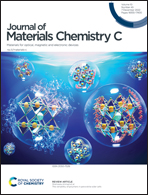Chiral coordination compounds with exceptional enantioselectivity†
Abstract
Systematic discovery of crystalline materials with noncentrosymmetric (NCS) structures revealing the structure-derived functional properties is an ongoing challenge. Two Zn-based chiral coordination compounds, [Zn2((R,R)-TBPG)2(H2O)5]·4H2O [(R)-Zn] and [Zn2((S,S)-TBPG)2(H2O)5]·4H2O [(S)-Zn] (TBPG = terephthaloyl-bis-phenyl glycine), were successfully synthesized via mild solvothermal reactions with the aid of the newly designed chiral organic ligands. (R)-Zn and (S)-Zn crystallizing in the NCS polar space group, P21, present very rare bilayer structures attributed to the strong π–π and hydrogen bonding interactions. Powder second harmonic generation (SHG) measurements indicate that (R)-Zn and (S)-Zn reveal SHG intensities of about 0.5 times that of KH2PO4 under 1064 nm radiation. The title compounds are very stable in a variety of different solvents in wide pH ranges. Surprisingly, ethyl alcohol is produced if crystals of the reported homochiral compound are immersed in diethyl ether. The homochiral title compounds also reveal exceptionally enantioselective sensing behavior toward the chiral amino acid, histidine. A plausible mechanism for the enantioselective discrimination of the reported materials is also proposed.

- This article is part of the themed collection: Circularly Polarised Luminescence


 Please wait while we load your content...
Please wait while we load your content...